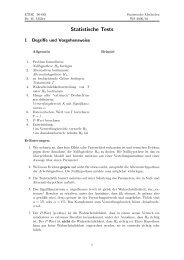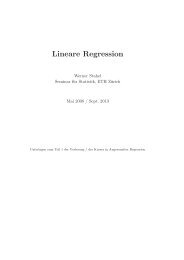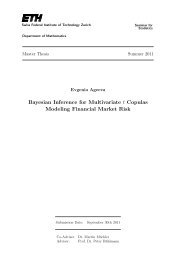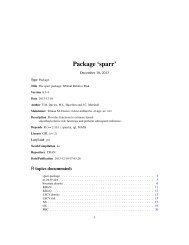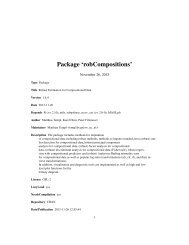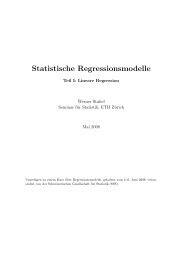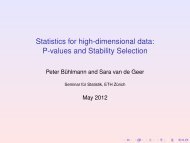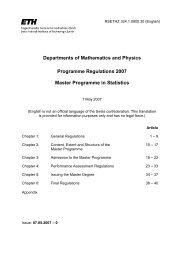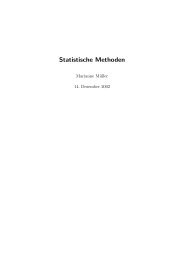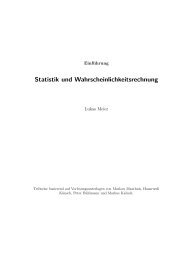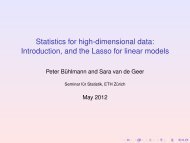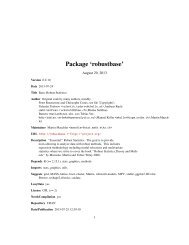Package 'rgenoud'
Package 'rgenoud'
Package 'rgenoud'
Create successful ePaper yourself
Turn your PDF publications into a flip-book with our unique Google optimized e-Paper software.
<strong>Package</strong> ‘rgenoud’<br />
August 29, 2013<br />
Version 5.7-12<br />
Date 2013-06-28<br />
Title R version of GENetic Optimization Using Derivatives<br />
Author Walter R. Mebane, Jr. , Jasjeet Singh Sekhon<br />
<br />
Maintainer Jasjeet Singh Sekhon <br />
Depends R (>= 2.15), utils, parallel<br />
Description A genetic algorithm plus derivative optimizer<br />
License GPL-3<br />
URL http://sekhon.berkeley.edu/rgenoud/<br />
NeedsCompilation yes<br />
Repository CRAN<br />
Date/Publication 2013-06-28 12:22:06<br />
R topics documented:<br />
genoud . . . . . . . . . . . . . . . . . . . . . . . . . . . . . . . . . . . . . . . . . . . . 2<br />
Index 14<br />
1
2 genoud<br />
genoud<br />
GENetic Optimization Using Derivatives<br />
Description<br />
Usage<br />
Genoud is a function that combines evolutionary search algorithms with derivative-based (Newton<br />
or quasi-Newton) methods to solve difficult optimization problems. Genoud may also be used for<br />
optimization problems for which derivatives do not exist. Genoud, via the cluster option, supports<br />
the use of multiple computers, CPUs or cores to perform parallel computations.<br />
genoud(fn, nvars, max=FALSE, pop.size=1000, max.generations=100, wait.generations=10,<br />
hard.generation.limit=TRUE, starting.values=NULL, MemoryMatrix=TRUE,<br />
Domains=NULL, default.domains=10, solution.tolerance=0.001,<br />
gr=NULL, boundary.enforcement=0, lexical=FALSE, gradient.check=TRUE,<br />
BFGS=TRUE, data.type.int=FALSE, hessian=FALSE,<br />
unif.seed=812821, int.seed=53058,<br />
print.level=2, share.type=0, instance.number=0,<br />
output.path="stdout", output.append=FALSE, project.path=NULL,<br />
P1=50, P2=50, P3=50, P4=50, P5=50, P6=50, P7=50, P8=50, P9=0,<br />
P9mix=NULL, BFGSburnin=0, BFGSfn=NULL, BFGShelp=NULL,<br />
control=list(),<br />
optim.method=ifelse(boundary.enforcement < 2, "BFGS", "L-BFGS-B"),<br />
transform=FALSE, debug=FALSE, cluster=FALSE, balance=FALSE, ...)<br />
Arguments<br />
fn<br />
nvars<br />
max<br />
pop.size<br />
The function to be minimized (or maximized if max=TRUE). The first argument<br />
of the function must be the vector of parameters over which minimizing is to<br />
occur. The function must return a scalar result (unless lexical=TRUE).<br />
For example, if we wish to maximize the sin() function. We can simply call<br />
genoud by genoud(sin, nvars=1,max=TRUE).<br />
The number of parameters to be selected for the function to be minimized (or<br />
maximized).<br />
Maximization (TRUE) or Minimizing (FALSE). Determines if genoud minimizes<br />
or maximizes the objective function.<br />
Population Size. This is the number of individuals genoud uses to solve the<br />
optimization problem. There are several restrictions on what the value of this<br />
number can be. No matter what population size the user requests, the number<br />
is automatically adjusted to make certain that the relevant restrictions are satisfied.<br />
These restrictions originate in what is required by several of the operators.<br />
In particular, operators 6 (Simple Crossover) and 8 (Heuristic Crossover) require<br />
an even number of individuals to work on—i.e., they require two parents.<br />
Therefore, the pop.size variable and the operators sets must be such that these<br />
three operators have an even number of individuals to work with. If this does
genoud 3<br />
not occur, the population size is automatically increased until this constraint is<br />
satisfied.<br />
max.generations<br />
Maximum Generations. This is the maximum number of generations that genoud<br />
will run when attempting to optimize a function. This is a soft limit. The maximum<br />
generation limit will be binding for genoud only if hard.generation.limit<br />
has been set equal to TRUE. If it has not been set equal to TRUE, two soft triggers<br />
control when genoud stops: wait.generations and gradient.check.<br />
Although the max.generations variable is not, by default, binding, it is nevertheless<br />
important because many operators use it to adjust their behavior. In<br />
essence, many of the operators become less random as the generation count gets<br />
closer to the max.generations limit. If the limit is hit and genoud decides to<br />
continue working, genoud automatically increases the max.generation limit.<br />
Please see MemoryMatrix for some important interactions with memory management.<br />
wait.generations<br />
If there is no improvement in the objective function in this number of generations,<br />
genoud will think that it has found the optimum. If the gradient.check<br />
trigger has been turned on, genoud will only start counting wait.generations<br />
if the gradients are within solution.tolerance of zero. The other variables<br />
controlling termination are max.generations and hard.generation.limit.<br />
hard.generation.limit<br />
This logical variable determines if the max.generations variable is a binding<br />
constraint for genoud. If hard.generation.limit is FALSE, then genoud<br />
may exceed the max.generations count if either the objective function has improved<br />
within a given number of generations (determined by wait.generations)<br />
or if the gradients are not zero (determined by gradient.check).<br />
Please see MemoryMatrix for some important interactions with memory management.<br />
starting.values<br />
A vector or matrix containing parameter values which genoud will use at startup.<br />
Using this option, the user may insert one or more individuals into the starting<br />
population. If a matrix is provided, the columns should be the variables and the<br />
rows the individuals. genoud will randomly create the other individuals.<br />
MemoryMatrix This variable controls if genoud sets up a memory matrix. Such a matrix ensures<br />
that genoud will request the fitness evaluation of a given set of parameters<br />
only once. The variable may be TRUE or FALSE. If it is FALSE, genoud will be<br />
aggressive in conserving memory. The most significant negative implication of<br />
this variable being set to FALSE is that genoud will no longer maintain a memory<br />
matrix of all evaluated individuals. Therefore, genoud may request evaluations<br />
which it has already previously requested.<br />
Note that when nvars or pop.size are large, the memory matrix consumes<br />
a large amount of RAM. Genoud’s memory matrix will require somewhat less<br />
memory if the user sets hard.generation.limit equal to TRUE.
4 genoud<br />
Domains<br />
This is a nvars ×2 matrix. For each variable, in the first column is the lower<br />
bound and in the second column the upper bound. None of genoud’s starting<br />
population will be generated outside of the bounds. But some of the operators<br />
may generate children which will be outside of the bounds unless the<br />
boundary.enforcement flag is turned on.<br />
If the user does not provide any values for Domains, genoud will setup default<br />
domains using default.domains.<br />
For linear and nonlinear constraints please see the discussion in the Note section.<br />
default.domains<br />
If the user does not want to provide a Domains matrix, domains may nevertheless<br />
be set by the user with this easy to use scalar option. Genoud will create a<br />
Domains matrix by setting the lower bound for all of the parameters equal to -1<br />
× default.domains and the upper bound equal to default.domains.<br />
solution.tolerance<br />
This is the tolerance level used by genoud. Numbers within solution.tolerance<br />
are considered to be equal. This is particularly important when it comes to evaluating<br />
wait.generations and conducting the gradient.check.<br />
gr<br />
A function to provide the gradient for the BFGS optimizer. If it is NULL, numerical<br />
gradients will be used instead.<br />
boundary.enforcement<br />
This variable determines the degree to which genoud obeys the boundary constraints.<br />
Notwithstanding the value of the variable, none of genoud’s starting<br />
population values will be outside of the bounds.<br />
lexical<br />
boundary.enforcement has three possible values: 0 (anything goes), 1 (partial),<br />
and 2 (no trespassing):<br />
• 0: Anything Goes This option allows any of the operators to create out-ofbounds<br />
individuals and these individuals will be included in the population<br />
if their fit values are good enough. The boundaries are only important when<br />
generating random individuals.<br />
• 1: partial enforcement This allows operators (particularly those operators<br />
which use the derivative based optimizer, BFGS) to go out-of-bounds during<br />
the creation of an individual (i.e., out-of-bounds values will often be<br />
evaluated). But when the operator has decided on an individual, it must be<br />
in bounds to be acceptable.<br />
• 2: No Trespassing No out-of-bounds evaluations will ever be requested. In<br />
this case, boundary enforcement is also applied to the BFGS algorithm,<br />
which prevents candidates from straying beyond the bounds defined by<br />
Domains. Note that this forces the use of the L-BFGS-B algorithm for<br />
optim. This algorithm requires that all fit values and gradients be defined<br />
and finite for all function evaluations. If this causes an error, it is suggested<br />
that the BFGS algorithm be used instead by setting boundary.enforcement=1.<br />
This option enables lexical optimization. This is where there are multiple fit<br />
criteria and the parameters are chosen so as to maximize fitness values in lexical
genoud 5<br />
order—i.e., the second fit criterion is only relevant if the parameters have the<br />
same fit for the first etc. The fit function used with this option should return a<br />
numeric vector of fitness values in lexical order. This option can take on the<br />
values of FALSE, TRUE or an integer equal to the number of fit criteria which are<br />
returned by fn. The value object which is returned by genoud will include all<br />
of the fit criteria at the solution. The GenMatch function makes extensive use of<br />
this option.<br />
gradient.check If this variable is TRUE, genoud will not start counting wait.generations unless<br />
each gradient is solution.tolerance close to zero. This variable has no<br />
effect if the max.generations limit has been hit and the hard.generation.limit<br />
option has been set to TRUE. If BFGSburnin < 0, then it will be ignored unless<br />
gradient.check = TRUE.<br />
BFGS<br />
data.type.int<br />
This variable denotes whether or not genoud applies a quasi-Newton derivative<br />
optimizer (BFGS) to the best individual at the end of each generation after the<br />
initial one. See the optim.method option to change the optimizer. Setting BFGS<br />
to FALSE does not mean that the BFGS will never be used. In particular, if you<br />
want BFGS never to be used, P9 (the Local-Minimum Crossover operator) must<br />
also be set to zero.<br />
This option sets the data type of the parameters of the function to be optimized.<br />
If the variable is TRUE, genoud will search over integers when it optimizes the<br />
parameters.<br />
With integer parameters, genoud never uses derivative information. This implies<br />
that the BFGS quasi-Newton optimizer is never used—i.e., the BFGS flag is set to<br />
FALSE. It also implies that Operator 9 (Local-Minimum Crossover) is set to zero<br />
and that gradient checking (as a convergence criterion) is turned off. No matter<br />
what other options have been set to, data.type.int takes precedence—i.e., if<br />
genoud is told that it is searching over an integer parameter space, gradient information<br />
is never considered.<br />
There is no option to mix integer and floating point parameters. If one wants<br />
to mix the two, it is suggested that the user pick integer type and in the objective<br />
function map a particular integer range into a floating point number range.<br />
For example, tell genoud to search from 0 to 100 and divide by 100 to obtain a<br />
search grid of 0 to 1.0 (by .1).<br />
hessian<br />
unif.seed<br />
Alternatively, the user could use floating point numbers and round the appropriate<br />
parameters to the nearest integer inside fn before the criterion (or criteria if<br />
lexical = TRUE) is evaluated. In that case, the transform option can be used<br />
to create the next generation from the current generation when the appropriate<br />
parameters are in the rounded state.<br />
When this flag is set to TRUE, genoud will return the hessian matrix at the solution<br />
as part of its return list. A user can use this matrix to calculate standard<br />
errors.<br />
This sets the seed for the floating-point pseudorandom number generator genoud<br />
uses. The default value of this seed is 81282. genoud uses its own internal pseudorandom<br />
number generator (a Tausworthe-Lewis-Payne generator) to allow for
6 genoud<br />
int.seed<br />
print.level<br />
share.type<br />
recursive and parallel calls to genoud. Repeated invocations without specifying<br />
this argument cause the program to continue drawing from its internal pseudorandom<br />
number stream, which is preserved in a static structure between invocations<br />
during the same R session, so the second invocation does not use the same<br />
pseudorandom numbers as the first. To produce exactly the same results in a<br />
subsequent invocation, one must explicitly provide the same, nondefault value<br />
for this argument. genoud does not use the seed set by R’s set.seed function.<br />
This will change in a subsequent version.<br />
This sets the seed for the integer pseudorandom number generator genoud uses.<br />
The default value of this seed is 53058. genoud uses its own internal pseudorandom<br />
number generator (a Tausworthe-Lewis-Payne generator) to allow for<br />
recursive and parallel calls to genoud. Repeated invocations without specifying<br />
this argument cause the program to continue drawing from its internal pseudorandom<br />
number stream, which is preserved in a static structure between invocations<br />
during the same R session, so the second invocation does not use the same<br />
pseudorandom numbers as the first. To produce exactly the same results in a<br />
subsequent invocation, one must explicitly provide the same, nondefault value<br />
for this argument. genoud does not use the seed set by R’s set.seed function.<br />
This will change in a subsequent version.<br />
This variable controls the level of printing that genoud does. There are four<br />
possible levels: 0 (minimal printing), 1 (normal), 2 (detailed), and 3 (debug). If<br />
level 2 is selected, genoud will print details about the population at each generation.<br />
The print.level variable also significantly affects how much detail<br />
is placed in the project file—see project.path. Note that R convention would<br />
have us at print level 0 (minimal printing). However, because genoud runs may<br />
take a long time, it is important for the user to receive feedback. Hence, print<br />
level 2 has been set as the default.<br />
If share.type is equal to 1, then genoud, at startup, checks to see if there is<br />
an existing project file (see project.path). If such a file exists, it initializes its<br />
original population using it. This option can be used neither with the lexical<br />
nor the transform options.<br />
If the project file contains a smaller population than the current genoud run,<br />
genoud will randomly create the necessary individuals. If the project file contains<br />
a larger population than the current genoud run, genoud will kill the necessary<br />
individuals using exponential selection.<br />
If the number of variables (see nvars) reported in the project file is different<br />
from the current genoud run, genoud does not use the project file (regardless of<br />
the value of share.type) and genoud generates the necessary starting population<br />
at random.<br />
instance.number<br />
This number (starting from 0) denotes the number of recursive instances of<br />
genoud. genoud then sets up its random number generators and other such<br />
structures so that the multiple instances do not interfere with each other. It is<br />
up to the user to make certain that the different instances of genoud are not writing<br />
to the same output file(s): see project.path.
genoud 7<br />
output.path<br />
output.append<br />
project.path<br />
P1<br />
P2<br />
P3<br />
P4<br />
P5<br />
P6<br />
For the R version of genoud this variable is of limited use. It is basically there<br />
in case a genoud run is being used to optimize the result of another genoud run<br />
(i.e., a recursive implementation).<br />
This option is no longer supported. It used to allow one to redirect the output.<br />
Now please use sink. The option remains in order to provide backward<br />
compatibility for the API.<br />
This option is no longer supported. Please see sink. The option remains in<br />
order to provide backward compatibility for the API.<br />
This is the path of the genoud project file. The project file prints one individual<br />
per line with the fit value(s) printed first and then the parameter values. By<br />
default genoud places its output in a file called "genoud.pro" located in the temporary<br />
directory provided by tempdir. The behavior of the project file depends<br />
on the print.level chosen. If the print.level variable is set to 1, then the<br />
project file is rewritten after each generation. Therefore, only the currently fully<br />
completed generation is included in the file. If the print.level variable is<br />
set to 2, then each new generation is simply appended to the project file. For<br />
print.level=0, the project file is not created.<br />
This is the cloning operator. genoud always clones the best individual each<br />
generation. But this operator clones others as well. Please see the Operators<br />
Section for details about operators and how they are weighted.<br />
This is the uniform mutation operator. One parameter of the parent is mutated.<br />
Please see the Operators Section for details about operators and how they are<br />
weighted.<br />
This is the boundary mutation operator. This operator finds a parent and mutates<br />
one of its parameters towards the boundary. Please see the Operators Section for<br />
details about operators and how they are weighted.<br />
Non-Uniform Mutation. Please see the Operators Section for details about operators<br />
and how they are weighted.<br />
This is the polytope crossover. Please see the Operators Section for details about<br />
operators and how they are weighted.<br />
Simple Crossover. Please see the Operators Section for details about operators<br />
and how they are weighted.<br />
P7 Whole Non-Uniform Mutation. Please see the Operators Section for details<br />
about operators and how they are weighted.<br />
P8<br />
P9<br />
P9mix<br />
Heuristic Crossover. Please see the Operators Section for details about operators<br />
and how they are weighted.<br />
Local-Minimum Crossover: BFGS. This is rather CPU intensive, and should be<br />
generally used less than the other operators. Please see the Operators Section<br />
for details about operators and how they are weighted.<br />
This is a tuning parameter for the P9 operator. The local-minimum crossover<br />
operator by default takes the convex combination of the result of a BFGS optimization<br />
and the parent individual. By default the mixing (weight) parameter<br />
for the convex combination is chosen by a uniform random draw between 0 and<br />
1. The P9mix option allows the user to select this mixing parameter. It may be<br />
any number greater than 0 and less than or equal to 1. If 1, then the BFGS result<br />
is simply used.
8 genoud<br />
BFGSburnin<br />
BFGSfn<br />
BFGShelp<br />
The number of generations which are run before the BFGS is first used. Premature<br />
use of the BFGS can lead to convergence to a local optimum instead<br />
of the global one. This option allows the user to control how many generations<br />
are run before the BFGS is started and would logically be a non-negative<br />
integer. However, if BFGSburnin < 0, the BFGS will be used if and when<br />
wait.generations is doubled because at least one gradient is too large, which<br />
can only occur when gradient.check = TRUE. This option delays the use of<br />
both the BFGS on the best individual and the P9 operator.<br />
This is a function for the BFGS optimizer to optimize, if one wants to make it<br />
distinct from the fn function. This is useful when doing lexical optimization<br />
because otherwise a derivative based optimizer cannot be used (since it requires<br />
a single fit value). It is suggested that if this functionality is being used, both<br />
the fn and BFGSfn functions obtain all of the arguments they need (except for<br />
the parameters being optimized) by lexical scope instead of being passed in as<br />
arguments to the functions. Alternatively, one may use the BFGShelp option<br />
to pass arguments to BFGSfn. If print.level > 2, the results from the BFGS<br />
optimizer are printed every time it is called.<br />
An optional function to pass arguments to BFGSfn. This function should take an<br />
argument named ‘initial’, an argument named ‘done’ that defaults to FALSE, or<br />
at least allow ... to be an argument. BFGSfn must have an argument named<br />
‘helper’ if BFGShelp is used because the call to optim includes the hard-coded<br />
expression helper = do.call(BFGShelp, args = list(initial = foo.vals), envir = e<br />
which evaluates the BFGShelp function in the environment of BFGSfn (fn is just<br />
a wrapper for BFGSfn) at par = foo.vals where foo.vals contains the<br />
starting values for the BFGS algorithm. The ‘done’ argument to BFGSfn is used<br />
if the user requests that the Hessian be calculated at the genoud solution.<br />
control A list of control parameters that is passed to optim if BFGS = TRUE or P9 > 0.<br />
Please see the optim documentation for details.<br />
optim.method<br />
transform<br />
A character string among those that are admissible for the method argument to<br />
the optim function, namely one of "BFGS", "L-BFGS-B", "Nelder-Mead", "CG",<br />
or "SANN". By default, optim.method is "BFGS" if boundary.enforcement < 2<br />
and is "L-BFGS-B" if boundary.enforcement = 2. For discontinuous objective<br />
functions, it may be advisable to select "Nelder-Mead" or "SANN". If selecting<br />
"L-BFGS-B" causes an error message, it may be advisable to select another<br />
method or to adjust the control argument. Note that the various arguments of<br />
genoud that involve the four letters “BFGS” continue to be passed to optim even<br />
if optim.method != "BFGS".<br />
A logical that defaults to FALSE. If TRUE, it signifies that fn will return a numeric<br />
vector that contains the fit criterion (or fit criteria if lexical = TRUE), followed<br />
by the parameters. If this option is used, fn should have the following general<br />
form in its body:<br />
par
genoud 9<br />
Details<br />
debug<br />
cluster<br />
balance<br />
users to implement their own operators.<br />
There are some issues that should be kept in mind. This option cannot be used<br />
when data.type.int = TRUE. Also, this option coerces MemoryMatrix to be<br />
FALSE, implying that the cluster option cannot be used. And, unless BFGSfn<br />
is specified, this option coerces gradient.check to FALSE, BFGS to FALSE, and<br />
P9 to 0. If BFGSfn is specified, that function should perform the transformation<br />
but should only return a scalar fit criterion, for example:<br />
par
10 genoud<br />
likelihood) is nonlinear in the model’s parameters, the function to be optimized will generally not be<br />
globally concave and may have irregularities such as saddlepoints or discontinuities. Optimization<br />
methods that rely on derivatives of the objective function may be unable to find any optimum at all.<br />
Multiple local optima may exist, so that there is no guarantee that a derivative-based method will<br />
converge to the global optimum. On the other hand, algorithms that do not use derivative information<br />
(such as pure genetic algorithms) are for many problems needlessly poor at local hill climbing.<br />
Most statistical problems are regular in a neighborhood of the solution. Therefore, for some portion<br />
of the search space, derivative information is useful for such problems. Genoud also works well for<br />
problems that no derivative information exists. For additional documentation and examples please<br />
see http://sekhon.berkeley.edu/rgenoud.<br />
Value<br />
genoud returns a list with 7 objects. 8 objects are returned if the user has requested the hessian to<br />
be calculated at the solution. Please see the hessian option. The returned objects are:<br />
value<br />
par<br />
gradients<br />
generations<br />
This variable contains the fitness value at the solution. If lexical optimization<br />
was requested, it is a vector.<br />
This vector contains the parameter values found at the solution.<br />
This vector contains the gradients found at the solution. If no gradients were<br />
calculated, they are reported to be NA.<br />
This variable contains the number of generations genoud ran for.<br />
peakgeneration This variable contains the generation number at which genoud found the solution.<br />
pop.size<br />
operators<br />
hessian<br />
This variable contains the population size that genoud actually used. See pop.size<br />
for why this value may differ from the population size the user requested.<br />
This vector reports the actual number of operators (of each type) genoud used.<br />
Please see the Operators Section for details.<br />
If the user has requested the hessian matrix to be returned (via the hessian<br />
flag), the hessian at the solution will be returned. The user may use this matrix<br />
to calculate standard errors.<br />
Operators<br />
Genoud has nine operators that it uses. The integer values which are assigned to each of these operators<br />
(P1· · ·P9) are weights. Genoud calculates the sum of s = P 1 + P 2 + · · · + P 9. Each operator<br />
is assigned a weight equal to W n =<br />
s<br />
P n<br />
. The number of times an operator is called usually equals<br />
c n = W n × pop.size.<br />
Operators 6 (Simple Crossover) and 8 (Heuristic Crossover) require an even number of individuals<br />
to work on—i.e., they require two parents. Therefore, the pop.size variable and the operators sets<br />
must be such that these three operators have an even number of individuals to work with. If this<br />
does not occur, genoud automatically upwardly adjusts the population size to make this constraint<br />
hold.
genoud 11<br />
Strong uniqueness checks have been built into the operators to help ensure that the operators produce<br />
offspring different from their parents, but this does not always happen.<br />
Note that genoud always keeps the best individual each generation.<br />
genoud’s 9 operators are:<br />
1. Cloning<br />
2. Uniform Mutation<br />
3. Boundary Mutation<br />
4. Non-Uniform Crossover<br />
5. Polytope Crossover<br />
6. Simple Crossover<br />
7. Whole Non-Uniform Mutation<br />
8. Heuristic Crossover<br />
9. Local-Minimum Crossover: BFGS<br />
For more information please see Table 1 of the reference article: http://sekhon.berkeley.edu/<br />
papers/rgenoudJSS.pdf.<br />
Note<br />
The most important options affecting performance are those determining population size (pop.size)<br />
and the number of generations the algorithm runs (max.generations, wait.generations, hard.generation.limit<br />
and gradient.check). Search performance is expected to improve as the population size and the<br />
number of generations the program runs for increase. These and the other options should be adjusted<br />
for the problem at hand. Please pay particular attention to the search domains (Domains and<br />
default.domains). For more information please see the reference article.<br />
Linear and nonlinear constraints among the parameters can be introduced by users in their fit function.<br />
For example, if the sum of parameters 1 and 2 must be less than 725, the following can be<br />
placed in the fit function the user is going to have genoud maximize: if ( (parm1 + parm2) >= 725) { return(-9999999<br />
In this example, a very bad fit value is returned to genoud if the linear constrain is violated. genoud<br />
will then attempt to find parameter values that satisfy the constraint.<br />
Alternatively, one can use lexical optimization where the first criterion is a binary variable that<br />
equals 1.0 iff (parm1 + parm2) < 725 and the second criterion is the fit function, which should<br />
also be passed to BFGSfn. All candidates where (parm1 + parm2) >= 725 will be ranked below<br />
all candidates where (parm1 + parm2) < 725 and within these two groups, candidates will be<br />
ranked by their fit on the second criterion. The optimal candidate is thus the one with the best fit on<br />
the second criterion among candidates that satisfy this restriction.
12 genoud<br />
Author(s)<br />
Walter R. Mebane, Jr., University of Michigan, , http://www-personal.<br />
umich.edu/~wmebane/<br />
Jasjeet S. Sekhon, UC Berkeley, , http://sekhon.berkeley.edu/<br />
References<br />
Mebane, Walter R., Jr. and Jasjeet S. Sekhon. 2011. "Genetic Optimization Using Derivatives: The<br />
rgenoud <strong>Package</strong> for R." Journal of Statistical Software, 42(11): 1-26. http://www.jstatsoft.<br />
org/v42/i11/<br />
Sekhon, Jasjeet Singh and Walter R. Mebane, Jr. 1998. “Genetic Optimization Using Derivatives:<br />
Theory and Application to Nonlinear Models.” Political Analysis, 7: 187-210. http:<br />
//sekhon.berkeley.edu/genoud/genoud.pdf<br />
Mebane, Walter R., Jr. and Jasjeet S. Sekhon. 2004. “Robust Estimation and Outlier Detection<br />
for Overdispersed Multinomial Models of Count Data.” American Journal of Political Science, 48<br />
(April): 391-410. http://sekhon.berkeley.edu/multinom.pdf<br />
Bright, H. and R. Enison. 1979. Quasi-Random Number Sequences from a Long-Period TLP<br />
Generator with Remarks on Application to Cryptography. Computing Surveys, 11(4): 357-370.<br />
See Also<br />
optim.<br />
Examples<br />
#maximize the sin function<br />
sin1
genoud 13<br />
#Plot the previous run<br />
xx
Index<br />
∗Topic nonlinear<br />
genoud, 2<br />
∗Topic optimize<br />
genoud, 2<br />
GenMatch, 5<br />
genoud, 2<br />
makeCluster, 9<br />
makePSOCKcluster, 9<br />
optim, 4, 8, 12<br />
set.seed, 6<br />
sink, 7<br />
tempdir, 7<br />
14




